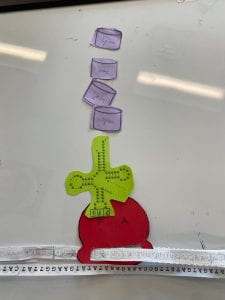Protein Synthesis
Proteins are made of a long chain of amino acids which is being coded for by DNA. The order of the basis of DNA determines which protein is made by coding for a specific order of amino acids.

Transcription
- DNA is converted into mRNA through transcription
- A copy of the small required portion of DNA will be created
- It’ll transport the desired protein’s genetic code from the nucleus to the ribosomes in the cytoplasm

Unwinding and unzipping
When a gene is switched on RNA polymerase attaches to DNA and causes it to unzip this is called the initiation stage
complementary base pairing with DNA
RNA is similar to DNA but does not contain thymine but instead contains uracil when there’s a strand of DNA messenger RNA or mRNA for short would pair up the adenine with the uracil. This stage is called elongation
 separation from DNA
separation from DNA
When the RNA polymerase reaches a stop code, it detaches from the DNA and the mRNA is complete. The mRNA exits the nucleus and moves into the cytoplasm where it finally finds a ribosome to start the next phase of protein synthesis known as translation.
Translation
 Messenger RNA → (to) protein is the process which is called translation because we’re translating that information into a polypeptide sequence.
Messenger RNA → (to) protein is the process which is called translation because we’re translating that information into a polypeptide sequence.
Initiation
The initiation phase is where the ribosome gets together with the mRNA and the first tRNA in the cytoplasm
elongation
When the tRNA transfers the amino acids to the ribosome, elongation occurs and the amino acids begin to link up to create a chain. Elongation should continue until the mRNA reads a stop codon.
 termination
termination
The amino acid chain is released at the termination point, resulting in a sequence of amino acids that eventually form polypeptide chains and proteins.
a) The models that we made in class accurately reflected the process because we were able to demonstrate the key components involved in protein synthesis and explain their roles by rearranging them on a board, so our models appropriately show the process. The colour-coded paper was a big help as well since it differentiates the function of each part so it wouldn’t confuse us. In a way since it is a less detailed version than the actual protein synthesis it also misrepresents the real process because it only contains the main process. A change that I would have made is to include more auditory and 3d/kinesthetic versions of the model because it would cater better to peoples learning styles and students would get educational benefits from those models.
b) Yes, I think models are a very effective way to educate the public about science because it caters to a lot of different learning styles this one is mainly a visual learning style. I find it more effective since it is way easier and more understandable to look at the visual aspect that goes along with the supporting text to understand the full concept of it instead of reading a long and wordy article or essay about it which would seem less appealing for the public to learn and read about. With the use of the models, the information would be basic and straightforward enough that those in the audience who are unfamiliar with the subject can quickly and effectively learn it.
Sources:
Amoeba Sisters – Protein Synthesis
Class OneNote (CYU protein synthesis) (Protien synthesis transcription)
Biology 12 in-class book










